ISSN ONLINE(2319-8753)PRINT(2347-6710)
ISSN ONLINE(2319-8753)PRINT(2347-6710)
|
Shanmuganathan J, Bennilo Fernandes J P.G. Student, Department of Electronics and Communication, Hindustan University, Padur, Chennai, India |
| Related article at Pubmed, Scholar Google |
Visit for more related articles at International Journal of Innovative Research in Science, Engineering and Technology
This project implements a solution for enhancing public transportation management services based on GSM. In this Project, design and development of a low cost transportation management system based on integration of GSM data with Transportation is described. The system comprises of various modules which are wirelessly linked with GSM modems. Cost effective SMS service of GSM network is used for the transfer of data between the modules. A new service, to facilitate the people who use public transport for travelling, is introduced inside the city. The service provides the user with current location information of desired buses based on which the user can adjust his schedule accordingly. The service therefore vanishes the need of waiting at the bus stop thus saving a lot of time. For the passengers not utilizing the service, displays are installed at bus stop to let them know the buses location coming towards that stop. The system is also efficient in handling the emergency situations. Based on the number of passengers and a recommendation report along with this analysis is sent to Tamil Nadu Government Transportation Department to have a check on the performance and services offered by transporters to common people
Keywords |
| Modem, SMS, GSM, Cost effective, transport management. |
INTRODUCTION |
| This project introduce a GSM based transportation management system that will help the passengers in getting informed about the exact schedule of buses and send suggestion report after performing statistical analysis on per stop basis to Tamilnadu Government for regulating the transport services. Nowadays, with the increasing number of people in cities of India, already existing problem of poor transportation services has grown to an alarming extent. Due to nonavailability of prior information about the buses arrival schedule, people have to wait longer on bus stops especially in morning when they have to reach the offices in time. The buses are overloaded for most of the times which often results in some kind of fault occurrence in buses and people get late further.RF transmitter and receiver are used for tracking while GSM is used as communication link between different modules. These modules include BUS Station Module, In- Bus Module, Road side Module and BUS Stop Module. Bus Station Module contains a GSM Modem interfaced to Microcontroller and transmits the bus route information to In-Bus module. The bus starts transmitting its location to the Bus Station and Bus stop module while crossing the Road side Module. BUS Stop Module after receiving buses location data through GSM engine displays it on dot matrix display installed at each bus stop. |
II. LITERATURE SURVEY: |
| Public transport system mostly comprises of passenger bus transport service offered by the private mode of transport and the State Govt. road transport undertakings. Nowadays, the private mode of transport is quite dominant as compared to State Road Transport Undertakings (SRTUs). At present there are 53 State Road Transport Undertakings having a total number of 1.13 lakh buses of varying fleet size. The SRTUs carry more than 6 crore passengers per day performing about 449 billion passenger kilometers. The share of buses as compared to the overall number of registered vehicles has declined from 11.1% in 1951 to 1.1% today even though they account for about 50% of all journeys performed by road. In contrast there has been an exponential growth of personalized mode of transport during this period especially during the last two decades. The proliferation of the personalized mode of transport has led to enormous problems of traffic congestion and pollution besides being a factor for increase number of road accidents. One of the reasons for the growth of the personalized mode of transport is the continuous degeneration in quality of service rendered by the public transport system and rising level of expectation of public/passengers. Despite rising demand of public transport in the rural/mofussil areas, there is hardly any established public transport system operating in rural/mofussil areas for connectivity with nearest towns/cities. In most of the areas the number of public transport buses operating under Stage Carriage permits is significantly low as compared to the demand. Thus, the buses operating in these areas are overcrowded. Moreover, in many areas people are forced to use substandard vehicles for commuting to/from these areas. The use of substandard vehicles is not only unsafe but also a major source of vehicular pollution. Therefore, it is felt that there is an urgent need to improve the quality of public transport in these areas with focused attention on improved connectivity to rural/mofussil areas. There are enough economic and environmental factors which suggest that the demand for better transport system (passenger bus service) would continue to increase if minimum quality of service is ensured and the quality of public transport and service is such that it can be sold as branded product to public. The financial position of the State Governments is well known. It has been observed for quite some time past that they are not able to provide adequate financial support required for upgrading the depleting public transport system in their respective states. Keeping the overall situation a need has been felt to address the problems faced by the public transport institutions so as to ensure that a better public transport mechanism is put in place which could be able to provide world class passenger bus service across the country. |
III. DESIGN METHODOLOGY |
| This system consists of four modules. The four modules are1. Bus station Module.2.In-Bus Module,3.Road side Module, 4.Bus Stop Module. 1. Bus Station Module:Bus station module is instal led at bus terminals where the bus wi ll depart. It is equipped wi th Microcontroller, GSM uni t, RF transmi tter and Encoder. This module is used to assig n the route number and dest ination.GSM unit is used to maintain the database of buses. |
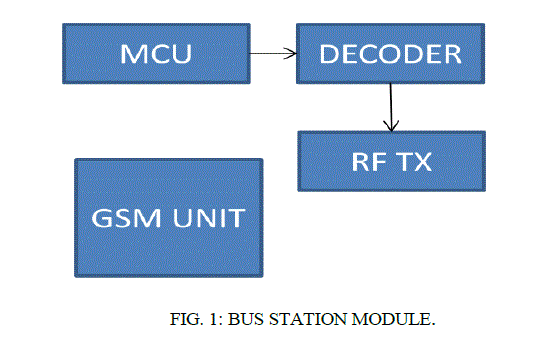 |
| 2. In-Bus Module:In-Bus module will be the base module for the entire process which consist of Microcontroller section interfaced to IR sensor counter pair, 16x2 LCD display, Decoder, GSM modem and RF receiver.LCD display is used to display route number destination and direction. GSM modem sends the bus information to Bus stop and server. RF receiver and decoder are used to receive the information from bus station and Road side modules. Two pair of IR sensors is connected to controller one to count the entry value and other to count exit value of the passengers in the bus. |
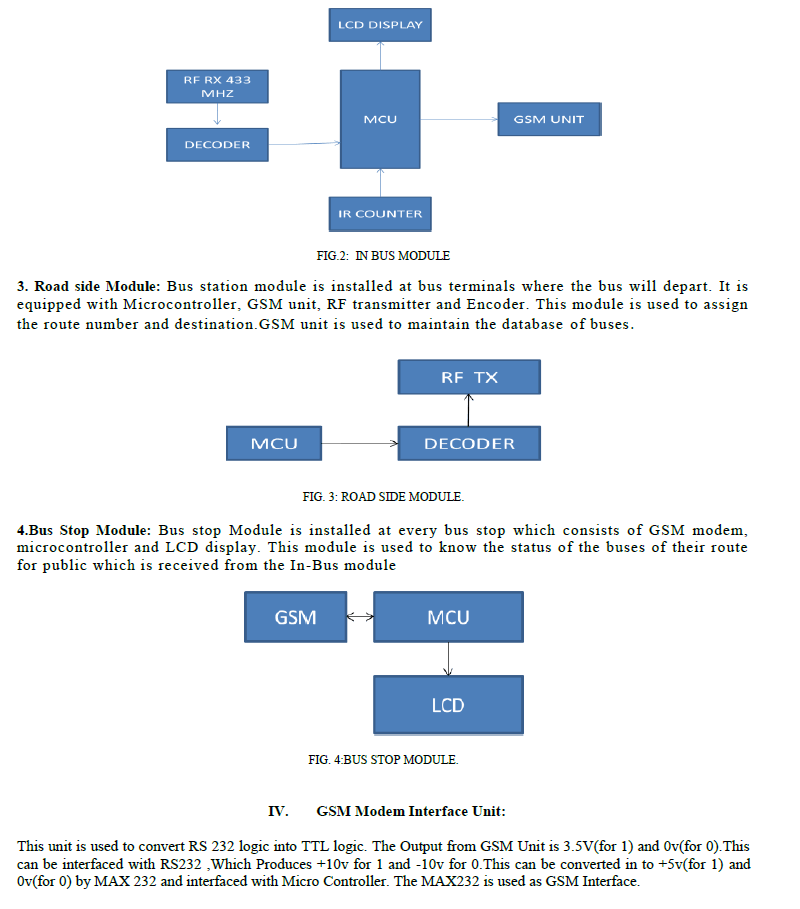 |
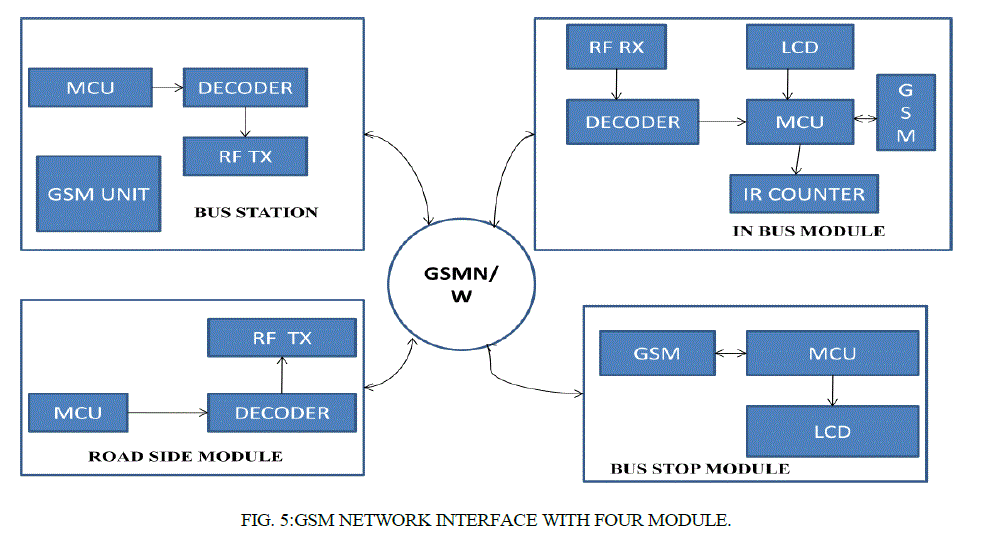 |
| Keil vision:The software used here is Keil vision, the IDE from Keil combines project management, make facilities, source code editing, program debugging, and complete simulation in one powerful environment. The μVision development platform is easy-to-use and helping you quickly create embedded programs that work. The μVision editor and debugger are integrated in a single application that provides a seamless embedded project development environment. Flash Magic is a PC tool for programming flash based microcontrollers from NXP using a serial or Ethernet protocol while in the target hardware |
V. EXPERIMENTAL PROCESS |
| The execution of the system is starts from the bus station module. Initially the bus station module bus details like bus number, bus starting and destination place from the in bus module .these process takes place by the microcontroller. Then the road side module is placed in every stop. so whenever the bus is crossed bus stop module ,data is transmitted and received the data between the in bus module and road side module through the GSM unit. Finally the upcoming stop and availability of the bus is displayed in bus stop module LCD display as well as the in bus module. the simulation of this system is executed by the keil tool.The simulation report and out diagram are shown in here . |
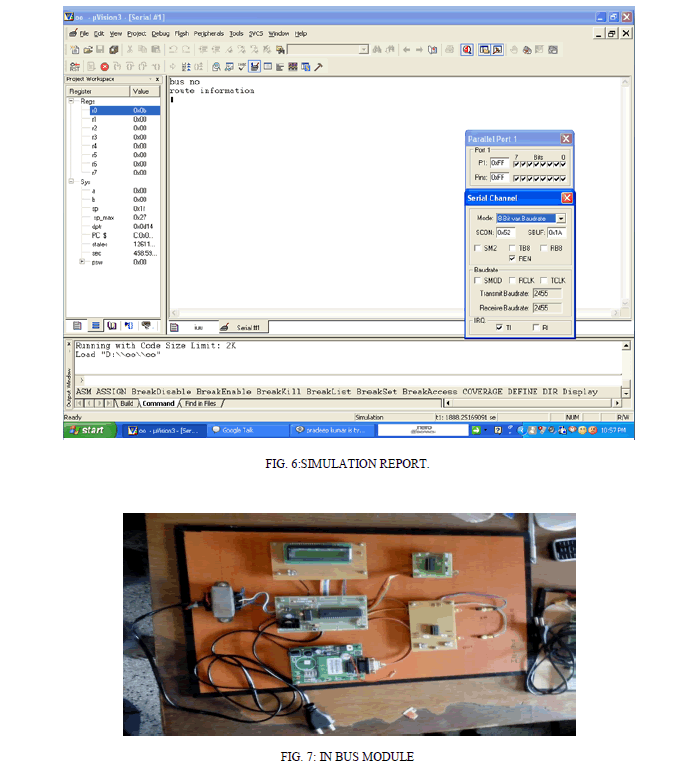 |
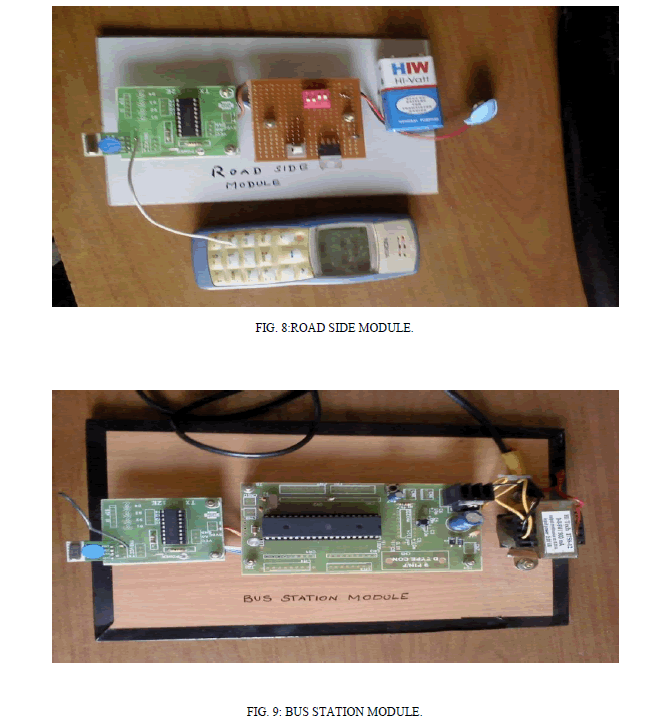 |
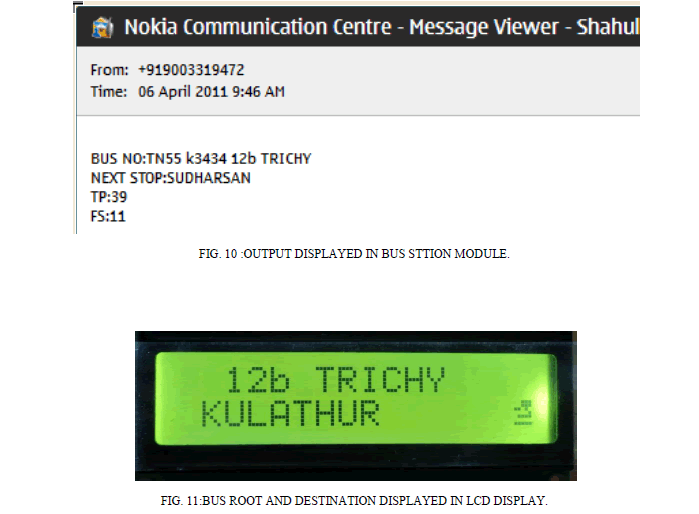 |
 |
VI. CONCLUSION |
| In this system, design and development of a low cost transportation management system based on GSM data is implement. Cost effective SMS service of GSM network is used for the transfer of data between the modules. A new system, to facilitate the people who use public transport for travelling, is introduced inside the city. Cost effective SMS service of GSM network is used for the transfer of data between the modules. A new service, to facilitate the people who use public transport for traveling, is introduced inside the city. The service provides the user with current location information of desired buses based on which the user can adjust his schedule accordingly. |